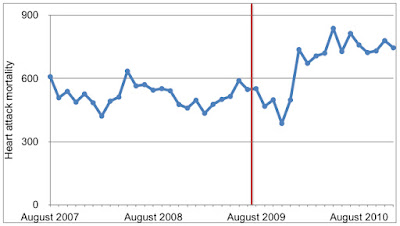This is their data on hospital admissions for myocardial infarction, with the smoking ban indicated by the red line...
And this is their data on mortality for myocardial infarction...
The first graph shows a notable rise from the pre-ban period but the second graph shows a dramatic increase. And yet the authors concluded:
We observed a reduction in mortality rate (−11.9% in the first 17 months after the law) and in hospital admission rate (−5.4% in the first 3 months after the law) for myocardial infarction after the implementation of the smoking ban law.
As usual in 'public health', the claim that something was 'observed' actually means that the data were fed into a model to produce the desired outcome, but what devilish model could have produced such a counter-intuitive conclusion? The authors say that only three variables were fed into the model: carbon monoxide levels, temperature and humidity.
Clive Bates left a comment on PubMed, suggesting that a more candid conclusion would read as follows:
RESULTS: We observed a substantial increase in mortality and hospital admissions for myocardial infarction after the implementation of the smoking ban law in Sao Paulo in August 2009. However, it is possible that other factors are responsible for this increase. After hand-picking a small number of possible confounding variables, and applying opaque statistical adjustments to account for their effect though without providing the data necessary for verification, we have been able to demonstrate that these increases could represent a modelled reduction in mortality attributable the smoking ban (−11.9% in the first 17 months after the law) and in hospital admission rate (−5.4% in the first 3 months after the law).
Last week, one of the authors responded with a partial explanation: incompetence.
After reviewing the entire paper, we noticed an error in data of the last column of Table 2. During the registration of information in Table 2, the last column mistakenly recorded incorrect monthly number of deaths for myocardial infarction. The correction will be done this week. Once this is an government data, it can be found in http://tabnet.datasus.gov.br/cgi/tabcgi.exe?sim/cnv/obt10SP.def
Yesterday, a new version of the paper was quietly uploaded to the Tobacco Control website substituting this table...
...for the one that had previously been published:
And the new version includes this mea culpa:
Correction notice This article has been corrected since it was published Online First. The values in the final column of Table 2 have been updated. Data concerning monthly number of deaths for myocardial infarction was provided by Health Ministry through Mortality Information System and DATASUS. During the registration of information in table 2, the last column mistakenly recorded the sum of the number of stroke deaths with the number of stroke and infarction added, that is, unreal numbers. The correct numbers are now shown. The information can be obtained in http://tabnet.datasus.gov.br/cgi/tabcgi.exe?sim/cnv/obt10SP.def. This information will not interfere with the rest of the analysis, because the analysis was done will the original data of deaths, not based in this table.
So they included all the stroke deaths alongside the heart attack deaths in 2010. A naive reader might expect this kind of thing to be picked up during peer review, but at Tobacco Control you'd be lucky if the reviewers notice a typo.
Assuming the new figures are correct, the graph of heart attack mortality should look like this:
This turns a startling rise into a more mundane continuation of the existing trend. If you can spot a 11.9% decline in the 17 months after the smoking ban then well done you. I can't. Nor do the figures for hospital admissions - which are correct, as far as we know - suggest that the smoking ban had any positive effect. The new figures for mortality mean the authors' claim is now deeply implausible rather than totally laughable.






No comments:
Post a Comment